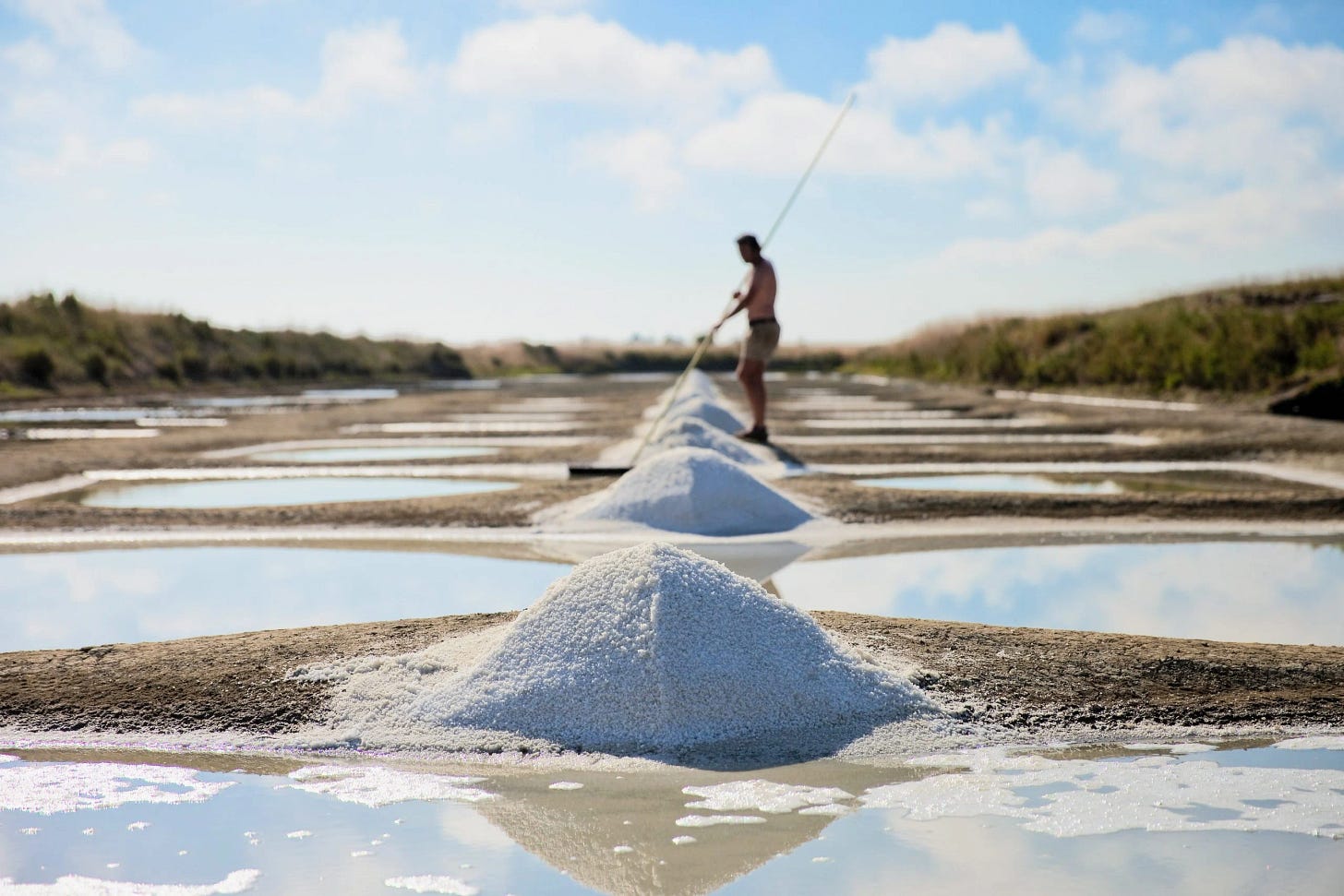*This newsletter is not intended to be medical advice. Supported by Mandy Murphy Carroll, RD MPH, Dr. Rosa Keller, PHD RD, Dr. Ricki Pollycove OBGYN, & Dr. Claire Packer OBGYN
HAPPY BIRTHDAY TO MWN!
Modern Women’s Nutrition just had it’s 1 year birthday!!! And my heart is so full. I could not be one year in, sharing all of my research and recipes, without your time reading, commenting, liking and supporting my work. Thank you so, so much, from the bottom of my heart. I’d love to give back by offering 1 free month to new subscribers — available for 1 week only.
Welcome to Modern Women’s Nutrition!
Empowering the busy modern woman to understand her hormone & metabolic health, and how to eat to thrive at every step of her journey—from fertility to menopause and beyond.
→ Jump to Recipe: Fleur de Sel Chocolate Covered Strawberries
Hi friends,
It’s early Summer in South-Western France – Biarritz, to be exact..
Large, orange, yellow and red heirloom tomato slices pop against my plate nestled beside torn mozzarella, basil leaves, and a few oil-cured olives. A drizzle of green-gold olive oil shimmers across everything.The sun is lingering, the rosé is chilled, and I reach across the table for the little pinch bowl filled with salt; not a shaker, but a pile of glistening crystals. Salies-de-Béarn fleur de sel, plucked from the marshes just a few miles away.
The sprinkle hits the tomato and glows. Each bite offers a whisper of the sea and of minerals, perfect for enriching all of these natural delicious elements on my tongue. The whole dish awakens.
In France, salt isn’t a vice, it’s a finishing touch. A way of enhancing the innate flavors of the foods we eat, not numbing them. Salt is something natural, of the earth, and a holistic part of our body’s wellbeing.
So when I hear women say, Ugh, I’m craving salt all the time, what’s wrong with me?
My answer is: Maybe your body is speaking to you in the only language it has.
Salt cravings often get dismissed as a bad habit, but they can actually be a biological cue, especially for women dealing with adrenal dysregulation or low blood pressure.
There is a distinction between reliance on salt in processed foods, which is a cheaper version of salt stripped of many of it’s important nutrients, and often added to packed goods in excess. Distinct from beautiful, flaky, mineral-rich salt that our bodies need.
When your body is under stress, whether it’s emotional stress, lack of sleep, overexercising, under-eating, or even chronic inflammation, your adrenal glands can take a hit. One key hormone they produce is aldosterone, which helps you retain sodium and regulate blood pressure.
When aldosterone levels drop, your body starts dumping salt through urine. That’s when you might notice the signs: dizziness when you stand up, intense cravings for chips, olives, or pickles, constant thirst, or exhaustion that doesn’t lift, even after a full night’s sleep.

When you’re stressed, your adrenal glands can become sluggish, affecting production of aldosterone, the hormone that helps you retain sodium and regulate blood pressure. If aldosterone is low, your body can start dumping salt, and you’ll feel it in one or more ways: lightheadedness, cravings for chips, olives, or pickles, constant thirst, or exhaustion that doesn’t lift with sleep.
Research backs this up:
Studies show that low sodium levels can activate your body’s internal stress system—the RAAS (renin-angiotensin-aldosterone) system—which works to help you conserve salt and maintain blood pressure. This system is meant to kick in temporarily, like when you’re dehydrated or sweating heavily, but when it’s constantly activated, from chronic low sodium intake, prolonged stress, or adrenal dysfunction, it can leave you feeling wiped out, wired-but-tired, anxious, or emotionally spent (source).
And when looking to maintain healthy sodium levels, it’s important to remember that not all salts are created equal: processed table salt is stripped and often laced with additives, while natural salts like sea salt and pink Himalayan salt contain trace minerals your body actually needs to support adrenal function and overall balance. Let’s just say you shouldn’t need to add iodine…
Grab a pinch of your everyday salt.
If it feels like dust and disappears instantly it’s highly refined
If it’s slightly moist, clumpy, or glistens, you’ve got minerals
Real salt has texture. It clumps. It tastes layered and alive. If your salt pours perfectly from a shaker and never cakes, it’s probably been bleached and stripped.

Here in France, salt is beautiful, not scary.
It’s thoughtfully used, never dumped on, never banned. No salt shakers on the table. Just perfect pinchesof flaky salt on top of our food, harvested from regions like Guérande in Brittany or Noirmoutier, where seawater is channeled into marshes and slowly evaporated by sun and wind, leaving behind mineral-rich crystals.
Traditional salts like fleur de sel and gris de sel are full of trace minerals like magnesium, calcium, and potassium. They haven’t been bleached, stripped, or refined. When you eat them, your body notices.
Before we go further, let’s take a closer look at electrolytes.
Electrolytes are essential minerals—sodium, potassium, magnesium, and calcium—that carry an electrical charge. That charge helps your body do everything from contract muscles to balance fluids to fire up your brain.
You lose electrolytes through sweat, stress, and even just breathing (yes, really! it’s called “insensible water loss,” which refers to the fluid your body loses through the water vapor expelled when breathing and through your skin.)

We’ve been conditioned to associate electrolyte replacement with sweaty athletes and neon sports drinks. But electrolyte imbalance can happen even when you’re living a normal life. And it can hit especially hard for women dealing with burnout, hormone shifts, postpartum depletion, or chronic stress.
If you’re going through big natural hormone and cycle changes in your life, like perimenopause or are looking for ways to lose stubborn belly fat or feel better, salt can be a big factor. We cover this deeply in The Blood Sugar Method, along with easy actionable items for you to improve your health and salt intake.
If your body is losing sodium and potassium faster than it can replace them (from adrenal dysfunction or low aldosterone) you may not feel simply thirsty, you may experience a range of symptoms like feeling:
Fuzzy-headed
Irritable
Constantly parched, even with lots of water
Exhausted even after rest
Yet most women I know are scared to add salt to their food, but consume chips and morning cereals loaded with added processed salt, and in turn they are undernourished from the natural minerals that help that water get absorbed by the body. Effective hydration is not just about water, it’s about what’s in your food that complements water.

If your hydration routine doesn’t include minerals, your cells can’t actually hold onto the water you drink. This is why adding a pinch of quality salt—think fleur de sel and pink Himalayan salt— is so much more than just a pop of flavor. It’s not just for digestion, but for cellular nourishment.
And with my reflection on living in France, I find that restaurants offer sparkling water that tastes better, and feels naturally better too. When I take a look at the label on these waters at a local French market, I see: magnesium, bicarbonate. sodium, potassium. Nature’s original electrolyte blend.
Not All Salt Is Created Equal
Let’s break down four types of salt!
If you’re always a little tired, always a little thirsty, always craving salt, you’re not alone. And you’re not broken.
In this section, I share exactly how I support electrolyte balance with real food, not formulas or flashy drinks.
Keep reading with a 7-day free trial
Subscribe to Modern Women's Nutrition to keep reading this post and get 7 days of free access to the full post archives.












